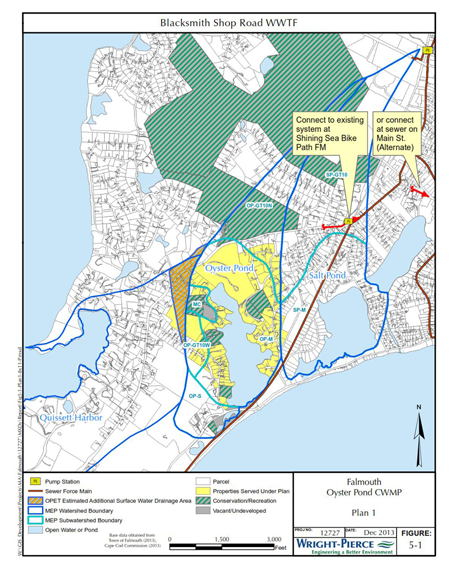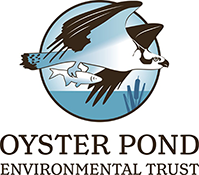On August 15, 2018, the Town of Falmouth Water Quality Management Committee (WQMC) held a meeting to discuss options for removing the excess nitrogen from Oyster Pond. It is looking for public input on the proposed plans for Oyster Pond. Video of the meeting is available and there is an article about the meeting in the Falmouth Enterprise.
The WQMC is responsible for seeking solutions for cleaning up Falmouth’s estuaries. Fifteen estuaries in Falmouth are degraded due to too much nitrogen. The Town of Falmouth is mandated to reduce this nitrogen entering these estuaries by the Clean Water Act of 1973. It is working with consultants to develop Comprehensive Wastewater Management Plans (CWMP) for each of these impacted water bodies. Oyster Pond is one of these estuaries and this meeting was to discuss the options for cleaning up the pond.

Proposed Treatment Plan 1 for Oyster Pond. Parcels in yellow would be connected to the sewer system. A total of 145 dwelling units from 85 parcels would be connected.

Proposed Treatment Plan 5 map for Advanced Innovative and Alternative Septic Systems. A total of 204 dwelling units would be required to upgrade to a denitrifying septic system. More parcels are included in this plan than in Plan 1. This is because all of the nutrients from households in Plan 1 would be taken out of the pond’s watershed. In contrast, nitrogen would still be released to the pond under Plan 5. This requires a greater number of homes to participate to meet the required nitrogen levels.
The high nitrogen levels in Oyster Pond are from too many conventional septic systems in the watershed. Existing Title V septic systems are great at removing pathogens from entering groundwater, but not nitrogen. Just as nitrogen feeds your garden plants, it also feeds the plants or algae in the pond. Too much nitrogen along with low salinity levels in the pond caused the algal bloom in the summer of 2016. Removing this pollution source will be the key to restoring Oyster Pond to a healthier ecosystem.
The two clean-up options include installing sewer lines in a portion of the watershed OR requiring nearly all the homes in the watershed to upgrade their septic system to a denitrifying system (the yellow areas in the above map).
The Town will decide between the two options over the next year. A final plan for Oyster Pond is due to the state Department of Environmental Protection (DEP) by December 2019.
Read more about these options in the Alternative Analysis section of the Comprehensive Wastewater Management Plan for Oyster Pond (CWMP).

